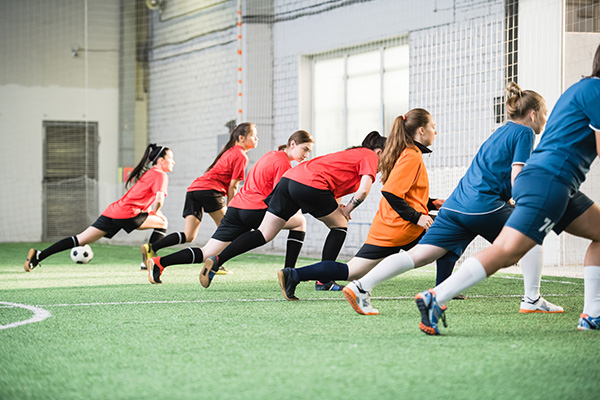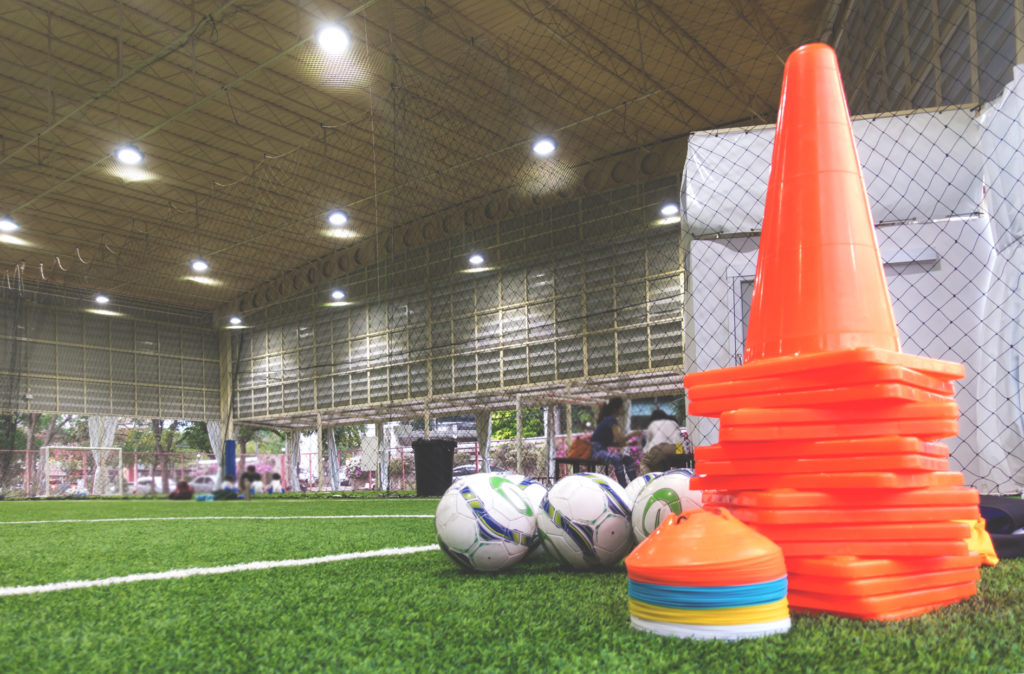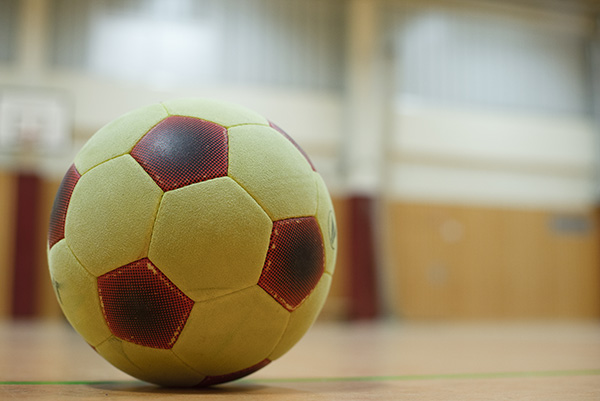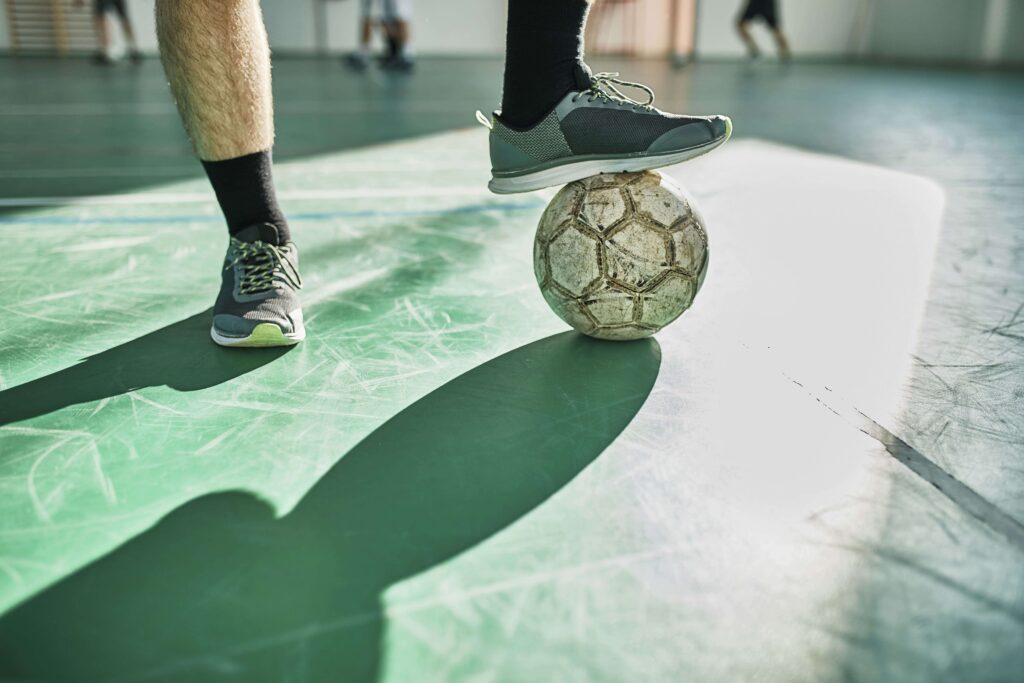Last Updated on: 2nd January 2025, 01:02 pm
At this time of year, you’ll be used to the British weather causing problems for your team. No doubt, you’ll have seen matches cancelled due to rain this season and some players will have skipped training. You want to keep momentum going but that isn’t always possible to train outside. Indoor football training can be a great alternative to keep players engaged and continue developing their skills. We’ve put together some tips and ideas so you can make the most out of your indoor training sessions.
Indoor vs Outdoor Training
Indoor football training has some unique advantages and can, with the right approach, be as effective as outdoor training. Although, they do require a slightly different approach. We’ve listed a few of the major differences below.

Space
Indoor facilities tend to have limited space. This means you’ll have to change the focus of your sessions. You can’t spend time on long passes and large formations. Instead, look at short passes, ball control and closer interactions.
Ball control
Footballs can be harder to control on indoor floors. They tend to bounce more and can be less predictable. Using softer indoor footballs or even futsal balls can help with this. They promote grounded, controlled play.
Adaptability
You might end up having to share indoor facilities so you need to be flexible. You players won’t have the space they usually do at training. Use existing court lines and smaller spaces to challenge players to adapt their technique and movement.
Intensified skill development
Indoor sessions are a great time to focus on footwork, close ball control, and quick decision-making. Players will be under more pressure in smaller spaces so will have to focus on their skills to succeed.
 Essential equipment
Essential equipment
You won’t have the space for some of the training equipment you might use in your normal training sessions. However, you will still be able to set up some useful drills. We think the following items would be useful for indoor football training sessions:
- Indoor footballs/futsal balls – designed to have better control and less bounce on indoor surfaces.
- Flat cones and markers – needed for setting boundaries and goals
- Training bibs – needed for team-based activities and mini-games
- Mini goals/Pop-up goals – portable goals make it easy to set up small-sided games inside.
Planning Your Indoor Session
1. Start with an arrival activity
This gets the players engaged with the session immediately. This is crucial if you have limited time and space.
Ideas:
- Individual dribbling – give a ball to each player and have them dribble. Get them to practice turns, fakes and changes in direction.
- 1v1 drills – set up pairs for 1v1 games. This is a great way to warm up as it’s fast and high-energy. It also gets the focus on skill-building from the start of the session.
- Wembley doubles – a classic game of Wembley doubles can be a great way to start the session. It gives it a fun and competitive edge from the start.
2. Utilise Existing Lines on the Court
Indoor courts are often lined for other sports, like netball or badminton. These can be useful for indoor football training sessions and setting up smaller drills.
Drill Ideas:
- 2v2 in a Small Area: Use the badminton tramlines as scoring zones. Players can score by stopping the ball on the line, promoting close control and accurate passing.
- 3v3 on a Partial Court: Use a third of a netball court to set boundaries for small-sided games. Playing within a confined space teaches players to adapt and make quick decisions.

3. Use a Futsal Ball for Better Control
Indoor floors can make footballs harder to control because of their high bounce. A futsal ball is denser, so it doesn’t bounce as much. Using a futsal ball will encourage ground-level passing, better control and more time on the ball. So, your players will improve their footwork and dribbling skills.
4. Play Small-Sided Games for Quick Engagement
You probably won’t have the space for full games inside but you can easily set up short, competitive games. Smaller games like 2v2 or 3v3 are competitive and high-energy to keep players engaged. They also have a quick turnover, so you can rotate often. This means all players remain engaged and get plenty of playing time.
Tip: use game breaks as coaching moments. Offer individual advice to work on during their next game. Have your players think about their strategy for the next game and plan things out with their team.
5. Incorporate Futsal for Skill Development
Futsal is a form of indoor football and can be a useful tool for skill development.
Benefits: Futsal focuses on close control, quick passes, and fast decision-making. These are all vital skills for every football player.
Format: Play 5v5 games on a netball court with a futsal ball. If you have a large group, run 3-minute games and then rotate the teams. Let the other players rest and think about strategy.
Drill Ideas for Indoor Football Training
Picking the drills for your indoor session will depend on how much space you have and how many players are coming. Setting up smaller drills and games will keep everyone engaged without things getting too crowded. Here are a few suggestions:
1. Circle Passing Drill
-
- Setup: Arrange players in a circle with one player in the middle. Outer players pass the ball around, and the middle player attempts to intercept.
- Objective: Quick passing, vision, and communication.
2. Wall Pass Relay
-
- Setup: Set up two walls or areas players can pass against.
- Objective: Practice one-twos and timed movement. This is also a great way to simulate give-and-go passing under pressure.
3. Small-Sided Possession Games
-
- Setup: In a confined area, two teams compete to maintain possession.
- Objective: Players improve ball control, shielding, and passing accuracy. This game encourages quick decision-making as they navigate limited space.
4. Timed Shooting Drill
-
- Setup: Players dribble from one end of the court to a marked goal area, where they must shoot within a set time.
- Objective: Fast-paced dribbling and controlled shooting, focusing on accuracy and power.
Have fun
The most important thing to remember is to have fun. Indoor football training sessions are a great way to keep your players working during bad weather and help them stay focused on the game. You want to make sure they stay engaged, so it’s a great time to incorporate football games. It will also help them focus on key skills, so they’re ready to get back outside.
Get Everything You Need
Make sure you’re ready for your next training session with our range of training equipment. Grab everything you need in one place. We’ve got cones, markers, poles and footballs plus kit bags, water bottles and bibs.
Tags: football, Football advice, football coaching, football drills, Football training, football training drills, football training equipment, indoor football training


